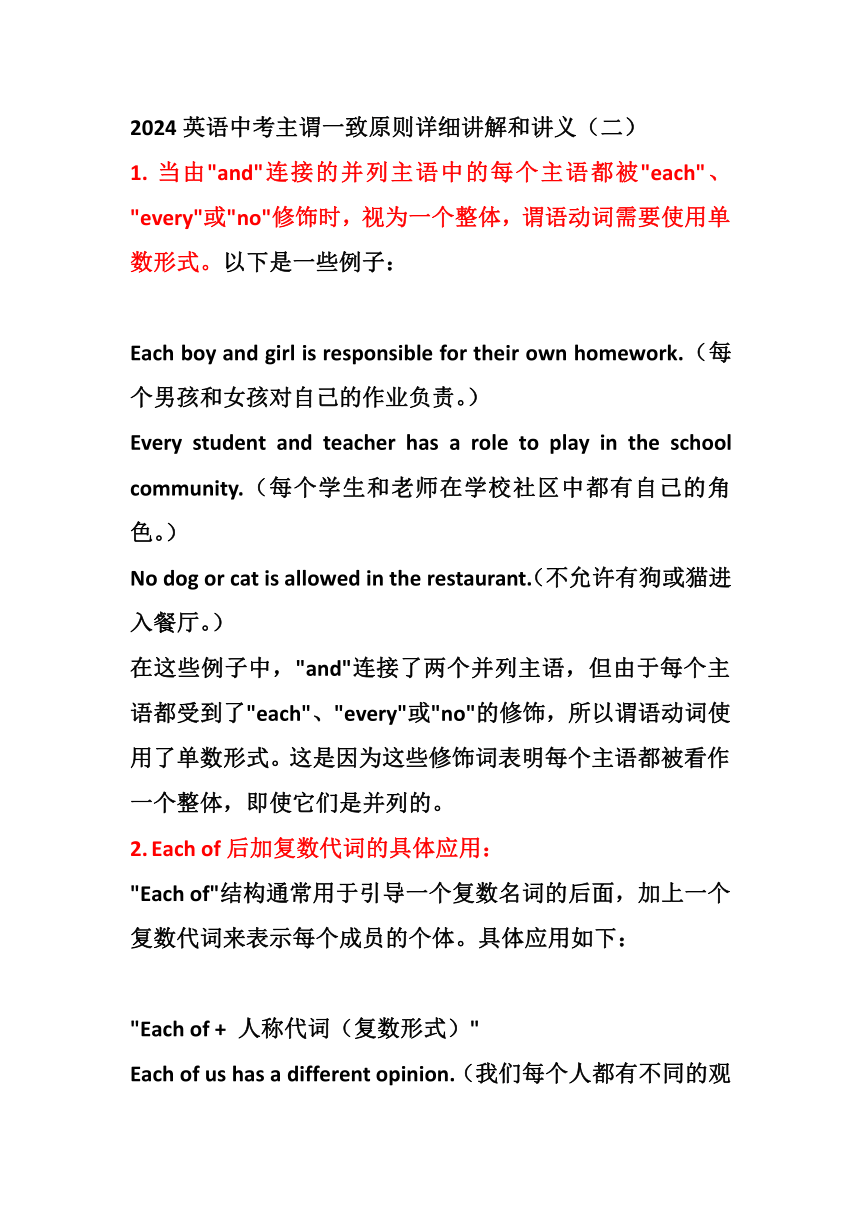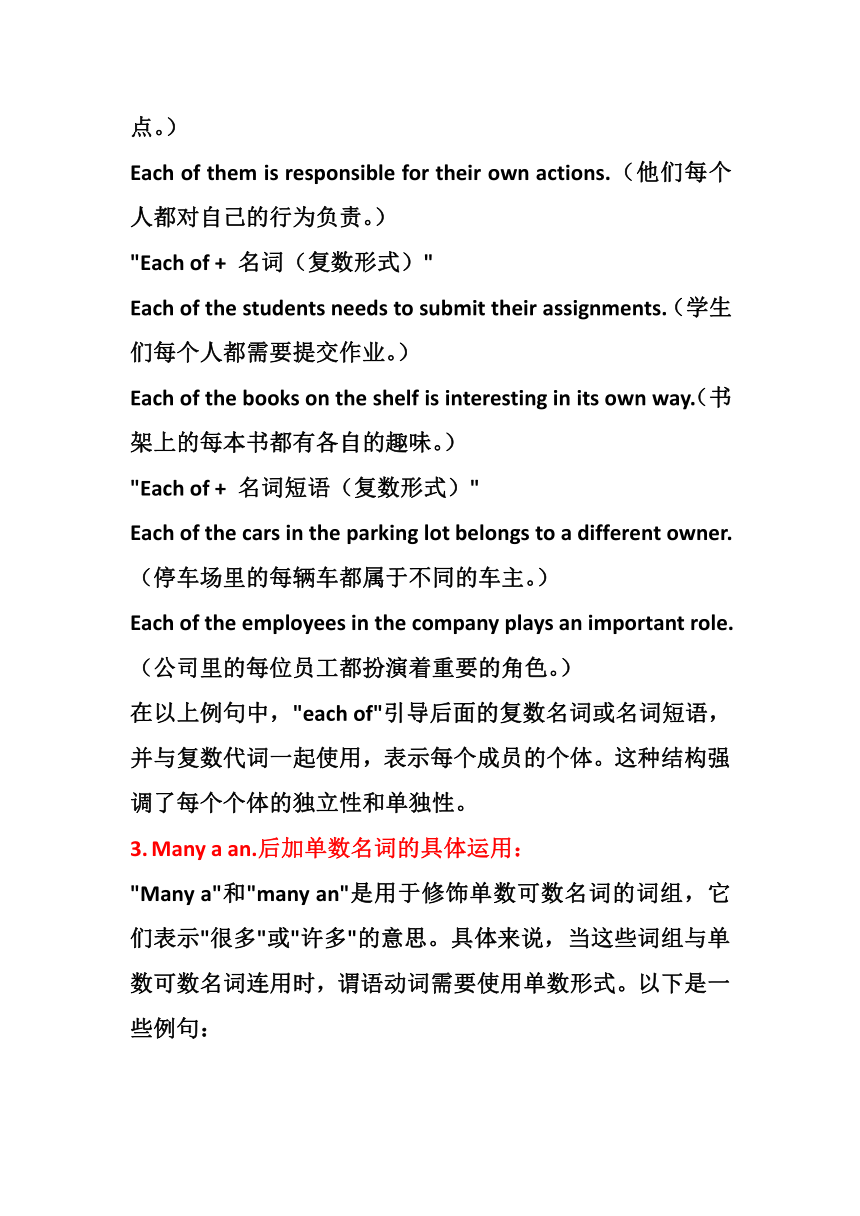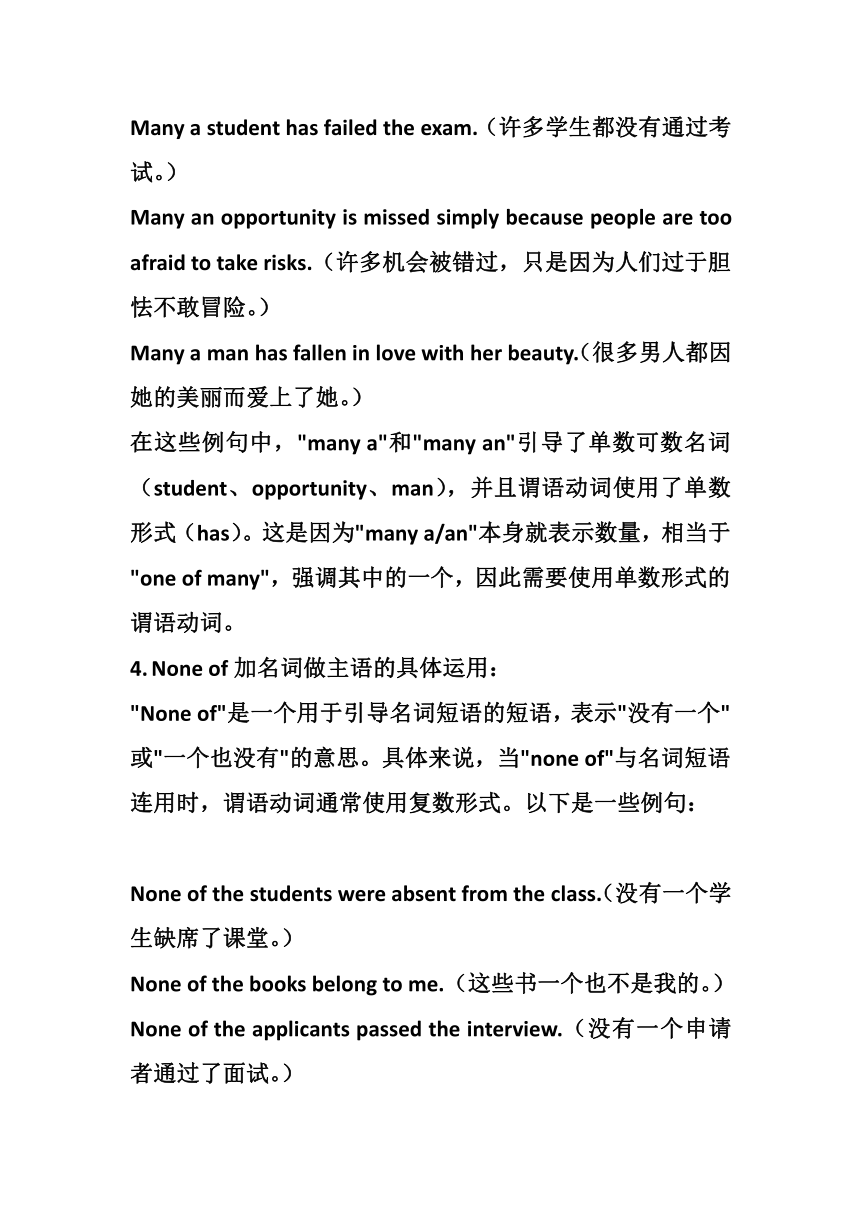2024年人教版中考英语复习主谓一致原则详细讲解和讲义(二)
文档属性
| 名称 | 2024年人教版中考英语复习主谓一致原则详细讲解和讲义(二) |

|
|
| 格式 | docx | ||
| 文件大小 | 19.9KB | ||
| 资源类型 | 教案 | ||
| 版本资源 | 人教新目标(Go for it)版 | ||
| 科目 | 英语 | ||
| 更新时间 | 2024-01-17 13:10:58 | ||
图片预览



文档简介
2024英语中考主谓一致原则详细讲解和讲义(二)
1. 当由"and"连接的并列主语中的每个主语都被"each"、"every"或"no"修饰时,视为一个整体,谓语动词需要使用单数形式。以下是一些例子:
Each boy and girl is responsible for their own homework.(每个男孩和女孩对自己的作业负责。)
Every student and teacher has a role to play in the school community.(每个学生和老师在学校社区中都有自己的角色。)
No dog or cat is allowed in the restaurant.(不允许有狗或猫进入餐厅。)
在这些例子中,"and"连接了两个并列主语,但由于每个主语都受到了"each"、"every"或"no"的修饰,所以谓语动词使用了单数形式。这是因为这些修饰词表明每个主语都被看作一个整体,即使它们是并列的。
2. Each of后加复数代词的具体应用:
"Each of"结构通常用于引导一个复数名词的后面,加上一个复数代词来表示每个成员的个体。具体应用如下:
"Each of + 人称代词(复数形式)"
Each of us has a different opinion.(我们每个人都有不同的观点。)
Each of them is responsible for their own actions.(他们每个人都对自己的行为负责。)
"Each of + 名词(复数形式)"
Each of the students needs to submit their assignments.(学生们每个人都需要提交作业。)
Each of the books on the shelf is interesting in its own way.(书架上的每本书都有各自的趣味。)
"Each of + 名词短语(复数形式)"
Each of the cars in the parking lot belongs to a different owner.(停车场里的每辆车都属于不同的车主。)
Each of the employees in the company plays an important role.(公司里的每位员工都扮演着重要的角色。)
在以上例句中,"each of"引导后面的复数名词或名词短语,并与复数代词一起使用,表示每个成员的个体。这种结构强调了每个个体的独立性和单独性。
3. Many a an.后加单数名词的具体运用:
"Many a"和"many an"是用于修饰单数可数名词的词组,它们表示"很多"或"许多"的意思。具体来说,当这些词组与单数可数名词连用时,谓语动词需要使用单数形式。以下是一些例句:
Many a student has failed the exam.(许多学生都没有通过考试。)
Many an opportunity is missed simply because people are too afraid to take risks.(许多机会被错过,只是因为人们过于胆怯不敢冒险。)
Many a man has fallen in love with her beauty.(很多男人都因她的美丽而爱上了她。)
在这些例句中,"many a"和"many an"引导了单数可数名词(student、opportunity、man),并且谓语动词使用了单数形式(has)。这是因为"many a/an"本身就表示数量,相当于"one of many",强调其中的一个,因此需要使用单数形式的谓语动词。
4. None of加名词做主语的具体运用:
"None of"是一个用于引导名词短语的短语,表示"没有一个"或"一个也没有"的意思。具体来说,当"none of"与名词短语连用时,谓语动词通常使用复数形式。以下是一些例句:
None of the students were absent from the class.(没有一个学生缺席了课堂。)
None of the books belong to me.(这些书一个也不是我的。)
None of the applicants passed the interview.(没有一个申请者通过了面试。)
在这些例句中,"none of"引导了名词短语(students、books、applicants),并且谓语动词使用了复数形式(were、belong、passed)。这是因为"none of"表示没有一个,强调没有任何一个成员符合特定条件,因此需要使用复数形式的谓语动词。
5.名词,如trousers clothes scissors gloves.Glasses等做主语时,谓语动词用复数形式的具体用法:
当类似trousers(裤子)、clothes(衣服)、scissors(剪刀)、gloves(手套)、glasses(眼镜)等不可数名词作为主语时,谓语动词通常使用复数形式。这是因为这些名词表示一组或一对物品,即使在意义上是单个物品,它们也被视为复数。
以下是几个例子:
My trousers are too tight.(我的裤子太紧了。)
These clothes need to be washed.(这些衣服需要洗。)
The scissors are sharp.(这把剪刀很锋利。)
Her gloves are lost.(她的手套丢了。)
His glasses are on the table.(他的眼镜放在桌子上。)
注意:的是,尽管这些名词以复数形式出现,但在描述它们的特征时,我们仍然使用单数形容词。例如,“These clothes need to be washed.”(这些衣服需要洗)中的形容词“washed”是用来描述“衣服(clothes)”的特征,而不是复数形式的形容词。
6. 比如news physics.Economics.The United States.等做主语时具体用法:
像news(新闻)、physics(物理学)、economics(经济学)等抽象名词作为主语时,谓语动词通常使用单数形式。这是因为它们表示的是一种概念或学科,而不是具体的个体或集合。
以下是几个例子:
The news is always changing.(新闻总是在变化。)
Physics is a challenging subject.(物理学是一门具有挑战性的学科。)
Economics is the study of how societies produce and distribute goods and services.(经济学是研究社会如何生产和分配商品和服务的学科。)
另外,像The United States(美国)这样的国家名词作为主语时,谓语动词的形式取决于该国家的名称中使用的复数或单数形式。例如:
The United States is a large country.(美国是一个大国。)
The Netherlands are known for their windmills.(荷兰以风车闻名。)
在第一个句子中,美国的名称是单数形式,因此谓语动词使用了单数形式的“is”。在第二个句子中,荷兰的名称是复数形式,因此谓语动词使用了复数形式的“are”。
7. the number of加名词作主语时的具体用法:
当使用"the number of"结构加上一个名词作为主语时,谓语动词的形式通常取决于该名词所表示的数量。以下是一些具体用法:
The number of students in the class is increasing.(班级里的学生数量在增加。)
The number of cars on the road has decreased.(路上的汽车数量减少了。)
The number of books in the library is impressive.(图书馆里的书的数量令人印象深刻。)
在这些例子中,"the number of"引导名词短语(students in the class, cars on the road, books in the library),而谓语动词的形式(is increasing, has decreased, is impressive)取决于名词短语所表示的数量。
注意:"the number of"结构是用来表示数量,因此谓语动词通常与"the number"保持一致,即使后面跟着的是复数名词。
1. 当由"and"连接的并列主语中的每个主语都被"each"、"every"或"no"修饰时,视为一个整体,谓语动词需要使用单数形式。以下是一些例子:
Each boy and girl is responsible for their own homework.(每个男孩和女孩对自己的作业负责。)
Every student and teacher has a role to play in the school community.(每个学生和老师在学校社区中都有自己的角色。)
No dog or cat is allowed in the restaurant.(不允许有狗或猫进入餐厅。)
在这些例子中,"and"连接了两个并列主语,但由于每个主语都受到了"each"、"every"或"no"的修饰,所以谓语动词使用了单数形式。这是因为这些修饰词表明每个主语都被看作一个整体,即使它们是并列的。
2. Each of后加复数代词的具体应用:
"Each of"结构通常用于引导一个复数名词的后面,加上一个复数代词来表示每个成员的个体。具体应用如下:
"Each of + 人称代词(复数形式)"
Each of us has a different opinion.(我们每个人都有不同的观点。)
Each of them is responsible for their own actions.(他们每个人都对自己的行为负责。)
"Each of + 名词(复数形式)"
Each of the students needs to submit their assignments.(学生们每个人都需要提交作业。)
Each of the books on the shelf is interesting in its own way.(书架上的每本书都有各自的趣味。)
"Each of + 名词短语(复数形式)"
Each of the cars in the parking lot belongs to a different owner.(停车场里的每辆车都属于不同的车主。)
Each of the employees in the company plays an important role.(公司里的每位员工都扮演着重要的角色。)
在以上例句中,"each of"引导后面的复数名词或名词短语,并与复数代词一起使用,表示每个成员的个体。这种结构强调了每个个体的独立性和单独性。
3. Many a an.后加单数名词的具体运用:
"Many a"和"many an"是用于修饰单数可数名词的词组,它们表示"很多"或"许多"的意思。具体来说,当这些词组与单数可数名词连用时,谓语动词需要使用单数形式。以下是一些例句:
Many a student has failed the exam.(许多学生都没有通过考试。)
Many an opportunity is missed simply because people are too afraid to take risks.(许多机会被错过,只是因为人们过于胆怯不敢冒险。)
Many a man has fallen in love with her beauty.(很多男人都因她的美丽而爱上了她。)
在这些例句中,"many a"和"many an"引导了单数可数名词(student、opportunity、man),并且谓语动词使用了单数形式(has)。这是因为"many a/an"本身就表示数量,相当于"one of many",强调其中的一个,因此需要使用单数形式的谓语动词。
4. None of加名词做主语的具体运用:
"None of"是一个用于引导名词短语的短语,表示"没有一个"或"一个也没有"的意思。具体来说,当"none of"与名词短语连用时,谓语动词通常使用复数形式。以下是一些例句:
None of the students were absent from the class.(没有一个学生缺席了课堂。)
None of the books belong to me.(这些书一个也不是我的。)
None of the applicants passed the interview.(没有一个申请者通过了面试。)
在这些例句中,"none of"引导了名词短语(students、books、applicants),并且谓语动词使用了复数形式(were、belong、passed)。这是因为"none of"表示没有一个,强调没有任何一个成员符合特定条件,因此需要使用复数形式的谓语动词。
5.名词,如trousers clothes scissors gloves.Glasses等做主语时,谓语动词用复数形式的具体用法:
当类似trousers(裤子)、clothes(衣服)、scissors(剪刀)、gloves(手套)、glasses(眼镜)等不可数名词作为主语时,谓语动词通常使用复数形式。这是因为这些名词表示一组或一对物品,即使在意义上是单个物品,它们也被视为复数。
以下是几个例子:
My trousers are too tight.(我的裤子太紧了。)
These clothes need to be washed.(这些衣服需要洗。)
The scissors are sharp.(这把剪刀很锋利。)
Her gloves are lost.(她的手套丢了。)
His glasses are on the table.(他的眼镜放在桌子上。)
注意:的是,尽管这些名词以复数形式出现,但在描述它们的特征时,我们仍然使用单数形容词。例如,“These clothes need to be washed.”(这些衣服需要洗)中的形容词“washed”是用来描述“衣服(clothes)”的特征,而不是复数形式的形容词。
6. 比如news physics.Economics.The United States.等做主语时具体用法:
像news(新闻)、physics(物理学)、economics(经济学)等抽象名词作为主语时,谓语动词通常使用单数形式。这是因为它们表示的是一种概念或学科,而不是具体的个体或集合。
以下是几个例子:
The news is always changing.(新闻总是在变化。)
Physics is a challenging subject.(物理学是一门具有挑战性的学科。)
Economics is the study of how societies produce and distribute goods and services.(经济学是研究社会如何生产和分配商品和服务的学科。)
另外,像The United States(美国)这样的国家名词作为主语时,谓语动词的形式取决于该国家的名称中使用的复数或单数形式。例如:
The United States is a large country.(美国是一个大国。)
The Netherlands are known for their windmills.(荷兰以风车闻名。)
在第一个句子中,美国的名称是单数形式,因此谓语动词使用了单数形式的“is”。在第二个句子中,荷兰的名称是复数形式,因此谓语动词使用了复数形式的“are”。
7. the number of加名词作主语时的具体用法:
当使用"the number of"结构加上一个名词作为主语时,谓语动词的形式通常取决于该名词所表示的数量。以下是一些具体用法:
The number of students in the class is increasing.(班级里的学生数量在增加。)
The number of cars on the road has decreased.(路上的汽车数量减少了。)
The number of books in the library is impressive.(图书馆里的书的数量令人印象深刻。)
在这些例子中,"the number of"引导名词短语(students in the class, cars on the road, books in the library),而谓语动词的形式(is increasing, has decreased, is impressive)取决于名词短语所表示的数量。
注意:"the number of"结构是用来表示数量,因此谓语动词通常与"the number"保持一致,即使后面跟着的是复数名词。
同课章节目录
